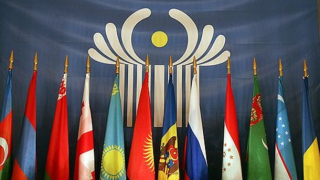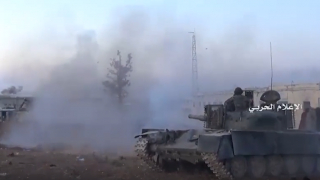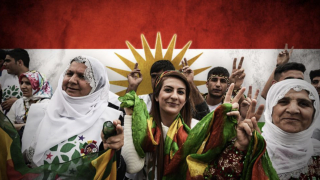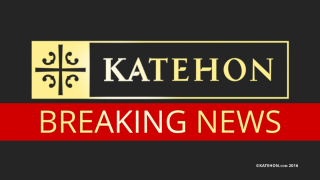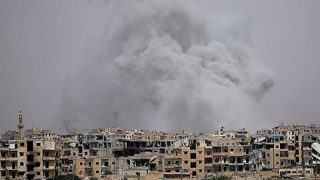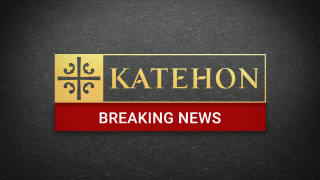The Hybrid-Network War in Syria
The armed conflict in Syria can be categorized perfectly under the concept of the network war. The tactics and behaviour of network-centric combatants (as a wide spectrum of actors has been called, from ecological activists to computer hackers to terrorists and separatists) have begun to be studied by intelligence services and soldiers, primarily in the US, not just for the purposes of combatting them, but also to copy their methods for use in regions of interest. Members of political opposition movements, dissidents, the disillusioned, and ethnic minorities, all these were selected to become participants in network wars; if critical mass could not be reached, a fake identity would be formed and constant propaganda would be produced for the preparation of necessary attitudes in the targeted country with the help of the Internet and the manipulation of information. In several cases the involvement of a large number of citizens helped to reach the desired effect in a peaceful way: this process received the name of ‘colour revolution’. In other regions similar initiatives were deliberately cut short, which is why the planners focussed on military strength, as was the case in Libya.
The use of radical Islamist slogans in similar situations (as applied to the Middle East) is highly effective, as it makes it possible to draw in a large number of volunteers for the ‘jihad’. On the other hand, Western countries can rid themselves of radical elements and fanatics by allowing them to travel to hot zones. Third, the main expenditures were not the burden of intelligence services and structures linked to them, but instead of ideologized rulers of the breed of autocrat which rules in Saudi-Arabia and Qatar, who could, in addition, use the unstable situation for their own geopolitical interests in the region.
The conflict itself took shape in several dimensions. Alongside the political and strategic levels there are the religious, ethnic and informational factors, which fanned the flames of the current war.
It was Salafism (Wahabbism) that was the binding factor which stimulated Saudi-Arabia to clean a foreign country of ‘infidels’, among which were not only Christians of different confessions, but also alawites (who are the ruling class of the country) and Shi’a. In this conflict Iran too positioned itself as an old religious and resource-seeking competitor of the Saudi’s, and Teheran’s military and economics support for Bashar Al-Assad only strengthened the country’s zeal. Saudi-Arabia was disturbed by Iran’s growing power and its influence in the region, especially in its role as the world centre of Shi’a Islam, seeing as followers of this denomination live in Saudi-Arabia, as well as neighbouring Bahrain, where they constitute a majority of inhabitants.
But a comparison of Syria with countries where a colour revolution occurred would, in our view, not be entirely correct. In Serbia, Georgia, Ukraine, and Kyrgyzstan, political protests occurred mainly in the capitals. Here, on the other hand, everything began in the periphery: the first disturbances took place on territories which neighbour Jordan, then close to Lebanon (Tal-Kalakh, Al-Qusayr), Turkey and Iraq (Abu-Kamal). Consequently, the logic of events was different, as in Syria resistance movements began in agrarian regions. We can say with confidence that the economic reforms begun by Assad in the middle of the 2000’s helped this development. They also partially created a base for future discontents as they led to social stratification. The situation resembled several Russian republics in the Northern Caucasus, where the agrarian youth formed several armed groups as it did not see any perspectives for itself and saw taking up arms as a just cause.
Alongside the abovementioned developments, the paradigm of neoliberal economics totally prevailed over the conflict. Syria was of interest to Western countries as a market for surplus production and a source for cheap labour, whether for the projects of multinational corporations, the entry of foreign capital into the country and the creation of new companies there or a debt cabal of bank loans and a program of structural regulation, which was forced upon the country by the World Bank and IMF and through the entire world in the beginning of the 90’s. As the war carried on Syria become an object of interest for companies busying themselves with the reconstruction of civil and industrial infrastructure, as wars and natural disasters have long been a source of income for such actors (initially the US State Department was linked to them). Naomi Klein described this process well in her book The Shock Doctrine: The Rise of Disaster Capitalism where she, at least partially, pointed out that where earlier the UN dealt with the resolution of the consequences of wars and disasters, the US had taken the initiative since 2004 by creating the Office of the Coordinator for Reconstruction and Stabilization. This office narrowly cooperated with the US National Intelligence Council. The most interesting fact is that in the list of countries where it would be necessary to rebuild infrastructure there often appeared states, where nothing extraordinary had happened yet; no tsunami’s, no earthquakes, no destructive civil wars, nothing.
A series of researches came to the logical conclusion that the US were planning to prove conflicts in these countries, all to later execute complex operations and begin reconstruction in favourable conditions.
Data gathered by Syrian intelligence services show that the conflict was prepared earlier. Before the beginning of mass demonstrations and the civil war a wide net of persons who had been involved in anti-government activities was discovered, which gave reason to conclude that a Libyan scenario was beginning to be realised against the government. Alongside Arab agents this net included agencies from the US, Great-Britain, Germany, and France. Intercepted data and arrests showed that modern equipment (Blackberry satellite phones) had been used, and that communications were conducted via a German military vessel anchored in the Mediterranean off the Syrian coastline. It is important to emphasize that communication devices are an important part of network-centric military action as they allow for the operational monitoring of the battlefield area and quick decision-making. It is not a coincidence that the West supported the armed opposition with modern methods of communication. Tactical network radio was also successfully rolled out in Iraq and Afghanistan by American soldiers. There is an important concept in the military operating doctrine of the US, which has been turned into a norm: the Boyd OODA (Observe-Orient-Decide-Act.1 According to this theory, the essence of effective combat is running through this loop quicker than your enemy, thereby not giving him a chance to take the initiative. To resist such a tactic, it is necessary to break the loop by penetrating one of its links, or by covering the enemy in a barrage of fire, which is the most commonly used strategy by the government armies in Syria.
Now we switch to the ethnic side of the conflict. Alongside the Kurds, who were actively supported by the USA (in Turkey as well), there live a great many different peoples. There are Armenians, many of which were located in Aleppo. There are also many natives of the Northern Caucasus. They are united under the common name of ‘Cherkess’: Balkars, Kabardynians, Vaynakh, Adyghe, Abkhaz, Shapsugs, Ossetins, and other ethnic groups, among which are several from Dagestan, are collected under the name. In the beginning of 2012 the Syrian armed opposition promised to deal with the Cherkess after they finished off Assad. Taking into account the fact that they traditionally served in the power structures of Syria and occupied positions of power in them, and that at the time of the Arab-Israeli Wars they constituted a majority of the rank and file in the Syrian army, and that they played a large role in the destruction of Islamic fundamentalist groups (among which was the ‘Muslim Brotherhood’ in the 80’s), a full genocide by the radical Salafists (if the Cherkess wouldn’t become part of them themselves) would have been guaranteed. It must be noted that the Cherkess factor resonated in Russia, where supporters of radical Islam in the Caucasus (and the Cherkess among them) started to accuse the Russian government of supporting the ‘bloody dictatorship’ of Assad. Turkey, a government which for a long time manipulated its Cherkess minority (including the Abkhaz, to whose youth it provides free education), duly declared its support for the Cherkess population in Syria.
The Turkmen are another people which has lived on the territory of Syria for centuries. Ankara could propose far more preferences for this ethnic group, among which were appeals to the common Turkic heritage, language, and culture. Syrian Turkmen have a compact living space in several regions: Latakia, Aleppo, Homs, Hama, Golan, and Sham. Turkey began to play its cards as far back as 1994, when in the city of Iskenderun an organisation for Turkmen cooperation called Bajir-Budzhak was started. Under the cover of humanitarian aid propaganda work was done by Ankara and a residency was created. The fact that political activity in a pro-Turkmen direction sharply increased immediately after the beginning of disturbances in 2011 points to such a possibility. A ‘Syrian Turkmen Movement’ and ‘Syrian Turkmen Group’ were founded, which united into a ‘Syrian Turkmen Bloc’. In addition, a ‘Democratic Syrian Turkmen Movement’ and an umbrella organisation, the ‘Syrian Turkmen Platform’, were organized. All organisations have cells in Syria itself, where they had a chance of future participation in politics. Alongside propaganda in social networks and among ethnic Turkmen, the organizations also have a military unit. This so-called division consisted of 12 units under the name of ‘Brigade of the Turkmen Mountain’. Its commander was colonel Muhammed Avad, under whose command were fighters in the province of Latakia. The Turkmen military presence in Aleppo was represented by Ali Basher. There they announced that they had a zone of 350 km under their control and were guaranteeing the security of areas populated by Turkmen. The following groups were under the command of this brigade: Nurgettin Zengri (headed by Ferdid Marsi, active in Latakia), which was part of the triumvirate of strongest and largest groups; Zakhir Beibars, which was active in the Avanli region; Al-Khuba Billi (which completes the triumvirate and was active between the settlements of Kastav and Beit Milik); Javuz Mekhmet Selim (commander of which was Tarik Sokhta, active in the Sheren region); Sultan Mekhmet the Conqueror (active in central Gimam); Memdukh Dzhokhla (active in Beit Farez, at first commanded by Mustafa Emin, who was killed and martyred and was replaced by Usama Kadi and later Emin Ibrahim); Bin Tamime (was located in the region of Nusairi village); Katib al-Mustafa; Firsan Tevkhid and Sukur ul Turkmen, which was considered to be the best organised group and was based in the city of Nusaibin. All these militarized units acted exclusively under the ‘Turkmen flag’ and separately from the diverse group of warriors, terrorists, and adventurists which took the brand of ‘Free Syrian Army’ or General Military Command.
The ‘Free Syrian Army’ is deserving of special attention. This structure was created with the help of Turkish intelligence services to collect all the different units in one body. Colonel Riad al-Assad, who deserted in July 2011, was located in the Apaidin refugee camp in Turkey, but lived separately from the civilian population. To meet with him, journalists had to go through a severe check and the final decision of access was made by the Turkish intelligence services. As is known, this brand [the Free Syrian Army] existed for about a year before several fighters started breaking off and claiming autonomy. However, there were initially also different organisations, such as Djabat al-Nusra (Al-Qaeda’s branch in Syria) and Akhrar al-Sham.
It is also known that in November 2011 around 600 warriors from the Libyan Al-Qaeda poured into the ‘Free Syrian Army’ (FSA). This operation was executed under the guidance of Abel Khakim Belkhadja, who, according to the affirmation of former Spanish prime minister Jose Maria Ansar, is suspected of having taken part in the organisation of the terror attacks in Madrid on the 11th of March 2004.2 Belkhadj himself is closely linked to Sheik Ali al-Salibi, who was chosen as the new leader of Libya. Not far from the Turkish border Al-Makhdi Khatari was noticed in the group, who has Libyan origins and lived in Ireland before joining Al-Qaeda. He commanded the Tripoli Brigade and was the second highest person of influence in the Tripoli Military Council after Abdel Khakim Belkhadj.3 Khatari laid down his position in Libya, having said that he wanted to return to his wife in Ireland; however, he travelled to Turkey and from there left for Syrian territory in command of a group of fighters.4
Next to those who acted under the command of colonel Riad there were also other formations: the FSA Military Council, which was commanded by brigade general Mustafa el-Sheikh; Kasem Sadiddina’s group in Homs; Mohammed Hussein el-Khadj Ali, who declared the formation of a Syrian National Army in September 2012; a united military command under the control of Adlan Selu; a ‘Syrian Support Group’, which was an NGO from the US and which was caught having ties to the CIA; a United Command of the Revolutionary-Military Committee and a General Command of the Committee of the Supreme United Military Command, headed by brigade general Salim Idris. Although among all listed groups there was no common consensus, they were not any less dangerous and were united by one goal: overthrowing the acting government.
It is also possible to look at this mixture of warriors through the prism of network warfare theory. In this theory there exists the concept of swarm tactics.
Its essence lies in attacks by small groups or individual activists against a larger and stronger opponent. Seeing as these groups are too small for one on one conflicts (which is useful for dispersion and the execution of different actions) but are very numerous, their actions do real damage to their target (if not bringing constant discomfort), and, in such a way, they gradually disrupt it. This technique was named by analogy for the actions of insects such as termites and bees, who defend their territory and hurl themselves at uninvited guests in unison. Different anti-globalist groups acted in such a way at several World Bank summits, the Economic Forum in Davos and other events of the global political elite. It is self-evident that swarm actions were strengthened by civil initiatives as well.
The ‘civil component’ in aggression against Syria was based on coordinating committees (Tansiqiyyat) which didn’t stress any ethnic or religious loyalties. They were dispersed over the entire country. A part of them openly helped fighters, another conducted sabotage, a third busied itself exclusively with protests and demonstrations. Such a rapidly changing character is a characteristic of network wars, where one type of work is done one day and on the other, depending on circumstances, the direction of actions is radically changed. And, because of their chameleon character, they are harder to identify. A ‘purely’ civilian element is linked to gender and media questions, the problems of involving children in armed conflict, and other human aspects. Their emissaries work abroad, lobbying for their interests in the corridors of power of foreign governments and receiving financial aid from them. Although the fundamental problem consists of terrorists and fighters, the role of ‘social actors’ must never be underestimated, seeing as they form public opinion and spread information precisely in the way that suits them and facts that help elucidate events can be twisted and hidden. There have already been cases in history where disinformation led to military intervention and, consequently, the groups’ desired result was a military intervention in Syria. One can name the media campaign over the usage of chemical weapons as one such attempt to gain foreign attention. In 2012 a part of the Western mass-media received information that the Syrian armies had loaded ammunition with mixes of toxic materials, which would then, consequently, be used in the next two weeks. However, chemical weaponry works in a different way: catalysts mix during the projectile’s flight just after firing, which means that it is not necessary to take any kind of time into account and specially prepare the projectile before a predetermined time. Because the common man doesn’t know such details and it’s unlikely that he will be interested by them, a similar injection of information could very well lead to the agitation of the masses and demands to national governments to use force according to the conception of ‘Responsibility to Protect’ (this doctrine was first tested under Bill Clinton during the intrusions into Haiti in 1994). However, these omissions and the twisting of information about chemical weapons were discovered by honest journalists in the West and the theme of chemical weapons use immediately collapsed. After the deployment of Russian soldiers in Syria the situation changed somewhat, but it remained tense until 2017, and the West, acting through its proxy agents (numerous groups, ‘white helmets’ etc.) organised new provocations.
1Леонид Савин. Пять стратегических колец Уордена и петля Бойда НОРД// Геополитика, 17.07.2017. https://www.geopolitica.ru/article/pyat-strategicheskih-kolec-uordena-i-petlya-boyda-nord
2 Spain’s Former Prime Minister Jose Maria Aznar on the Arab Awakening and How the West Should React,” CNBC.com., 9 December 2011.
3 Fitzgerald, Mary. Libyan-Irish commander resigns as deputy head of Tripoli military council. The Irish Times, 11 October 2011.
4 Meyssan, Thierry. Free Syrian Army commanded by Military Governor of Tripoli. 23 Dec. 2011. http://counterpsyops.com/2011/12/23/free-syrian-army-commanded-by-military-governor-of-tripoli/#more-3505
___
Translated from Russian by V.A.V.



